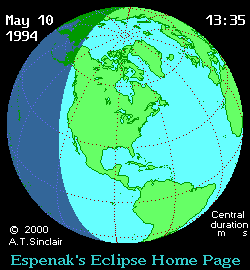Solar eclipse of May 10, 1994
| Solar eclipse of May 10, 1994 | |
|---|---|
 Partial from Bismarck, North Dakota, USA | |
| Type of eclipse | |
| Nature | Annular |
| Gamma | 0.4077 |
| Magnitude | 0.9431 |
| Maximum eclipse | |
| Duration | 373 s (6 min 13 s) |
| Coordinates | 41°30′N 84°06′W / 41.5°N 84.1°W |
| Max. width of band | 230 km (140 mi) |
| Times (UTC) | |
| Greatest eclipse | 17:12:27 |
| References | |
| Saros | 128 (57 of 73) |
| Catalog # (SE5000) | 9495 |
An annular solar eclipse occurred on Tuesday, May 10, 1994. It was visible over a wide swath of North America, from Baja California across the Midwest of the United States up through Ontario and Nova Scotia in Canada.
The Annular Eclipse of May 10, 1994
A solar eclipse occurs when the Moon passes between Earth and the Sun, thereby totally or partly obscuring the image of the Sun for a viewer on Earth. The eclipse is either total or annular. In a total eclipse, the moon's size from earth is large enough to block all of the disk of the sun.
An annular solar eclipse occurs when the Moon's apparent diameter is smaller than the Sun's, blocking most of the Sun's light and causing the Sun to look like an annulus (ring), that is there is a ring of the sun around the dark moon. An annular eclipse appears as a partial eclipse over a region of the Earth thousands of kilometres wide.
The path of annularity crossed four states of Mexico (Baja California Sur, Baja California, Sonora and Chihuahua), the United States, the Canadian provinces of Ontario, Nova Scotia and the southeastern tip of Quebec, Azores Islands except Santa Maria Island, and part of Morocco including the capital city Rabat. Niagara Falls was also covered by the path of annularity.
Images
Related eclipses
Solar eclipses 1993–1996
This eclipse is a member of a semester series. An eclipse in a semester series of solar eclipses repeats approximately every 177 days and 4 hours (a semester) at alternating nodes of the Moon's orbit.[1]
| Solar eclipse series sets from 1993 to 1996 | ||||||
|---|---|---|---|---|---|---|
| Descending node | Ascending node | |||||
| Saros | Map | Gamma | Saros | Map | Gamma | |
| 118 | May 21, 1993 Partial |
1.1372 | 123 | November 13, 1993 Partial |
−1.0411 | |
128 Partial in Bismarck, ND, USA |
May 10, 1994 Annular |
0.4077 | 133 Totality in Bolivia |
November 3, 1994 Total |
−0.3522 | |
| 138 | April 29, 1995 Annular |
−0.3382 | 143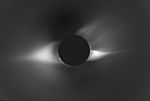 Totality in Dundlod, India |
October 24, 1995 Total |
0.3518 | |
| 148 | April 17, 1996 Partial |
−1.058 | 153 | October 12, 1996 Partial |
1.1227 | |
Saros 128
This eclipse is a part of Saros series 128, repeating every 18 years, 11 days, and containing 73 events. The series started with a partial solar eclipse on August 29, 984 AD. It contains total eclipses from May 16, 1417 through June 18, 1471; hybrid eclipses from June 28, 1489 through July 31, 1543; and annular eclipses from August 11, 1561 through July 25, 2120. The series ends at member 73 as a partial eclipse on November 1, 2282. Its eclipses are tabulated in three columns; every third eclipse in the same column is one exeligmos apart, so they all cast shadows over approximately the same parts of the Earth.
The longest duration of totality was produced by member 27 at 1 minutes, 45 seconds on June 7, 1453, and the longest duration of annularity was produced by member 48 at 8 minutes, 35 seconds on February 1, 1832. All eclipses in this series occur at the Moon’s descending node of orbit.[2]
| Series members 47–68 occur between 1801 and 2200: | ||
|---|---|---|
| 47 | 48 | 49 |
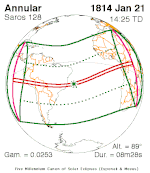 January 21, 1814 |
 February 1, 1832 |
 February 12, 1850 |
| 50 | 51 | 52 |
 February 23, 1868 |
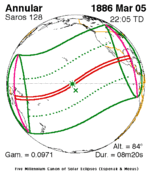 March 5, 1886 |
 March 17, 1904 |
| 53 | 54 | 55 |
 March 28, 1922 |
 April 7, 1940 |
 April 19, 1958 |
| 56 | 57 | 58 |
 April 29, 1976 |
 May 10, 1994 |
 May 20, 2012 |
| 59 | 60 | 61 |
 June 1, 2030 |
 June 11, 2048 |
 June 22, 2066 |
| 62 | 63 | 64 |
 July 3, 2084 |
 July 15, 2102 |
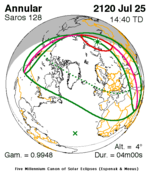 July 25, 2120 |
| 65 | 66 | 67 |
 August 5, 2138 |
 August 16, 2156 |
 August 27, 2174 |
| 68 | ||
 September 6, 2192 | ||
Metonic cycle
The metonic series repeats eclipses every 19 years (6939.69 days), lasting about 5 cycles. Eclipses occur in nearly the same calendar date. In addition, the octon subseries repeats 1/5 of that or every 3.8 years (1387.94 days). All eclipses in this table occur at the Moon's descending node.
| 21 eclipse events between July 22, 1971 and July 22, 2047 | ||||
|---|---|---|---|---|
| July 22 | May 9–11 | February 26–27 | December 14–15 | October 2–3 |
| 116 | 118 | 120 | 122 | 124 |
 July 22, 1971 |
 May 11, 1975 |
 February 26, 1979 |
 December 15, 1982 |
 October 3, 1986 |
| 126 | 128 | 130 | 132 | 134 |
 July 22, 1990 |
 May 10, 1994 |
 February 26, 1998 |
 December 14, 2001 |
 October 3, 2005 |
| 136 | 138 | 140 | 142 | 144 |
 July 22, 2009 |
 May 10, 2013 |
 February 26, 2017 |
 December 14, 2020 |
 October 2, 2024 |
| 146 | 148 | 150 | 152 | 154 |
 July 22, 2028 |
 May 9, 2032 |
 February 27, 2036 |
 December 15, 2039 |
 October 3, 2043 |
| 156 | ||||
 July 22, 2047 | ||||
References
- ^ van Gent, R.H. "Solar- and Lunar-Eclipse Predictions from Antiquity to the Present". A Catalogue of Eclipse Cycles. Utrecht University. Retrieved 6 October 2018.
- ^ "NASA - Catalog of Solar Eclipses of Saros 128". eclipse.gsfc.nasa.gov.
External links
- Example of total versus annular eclipse
- Earth visibility chart and eclipse statistics Eclipse Predictions by Fred Espenak, NASA/GSFC
Photos:
- Solstice And Season's Eclipse APOD 21 December 2000, partial annular eclipse


